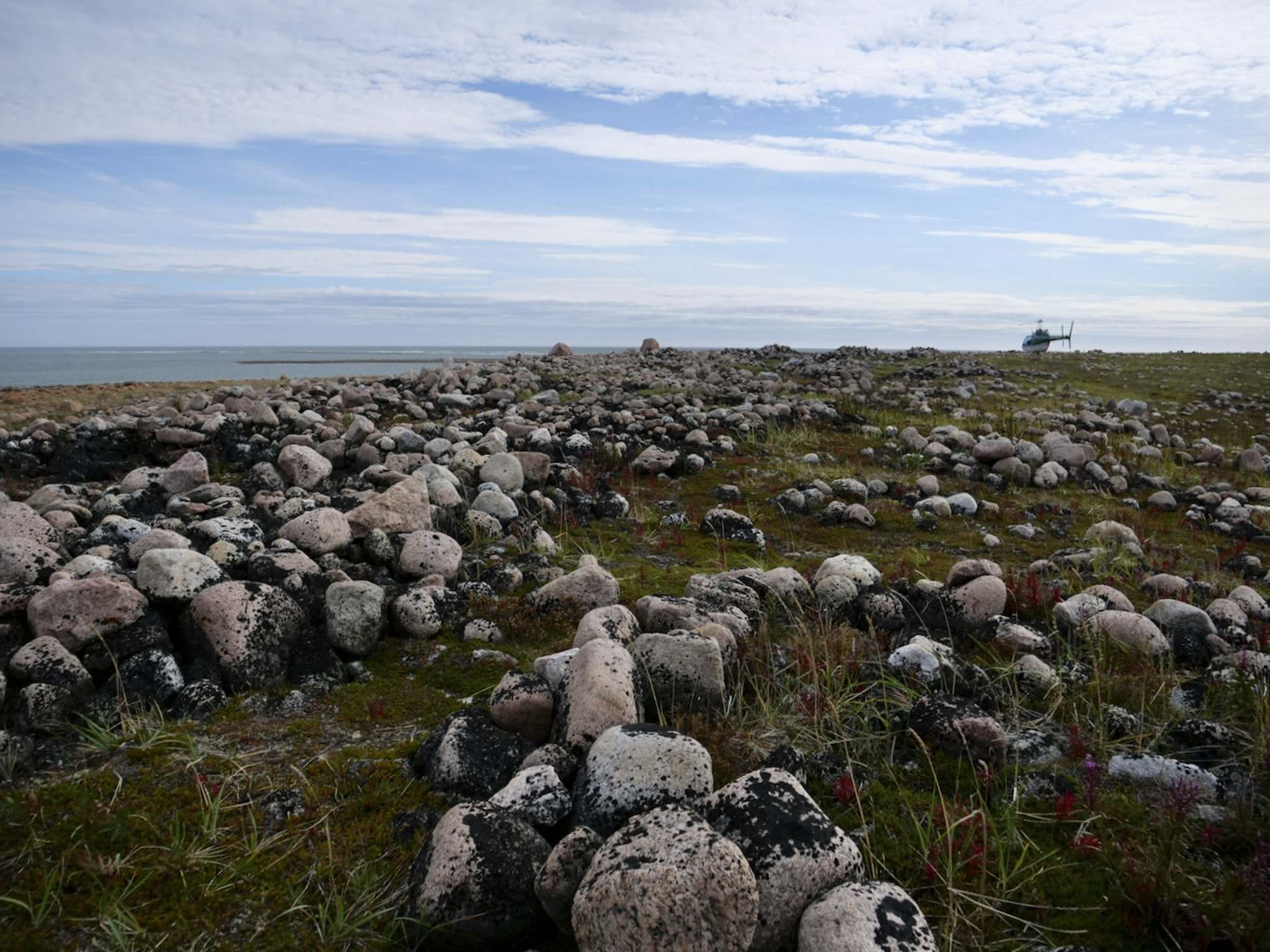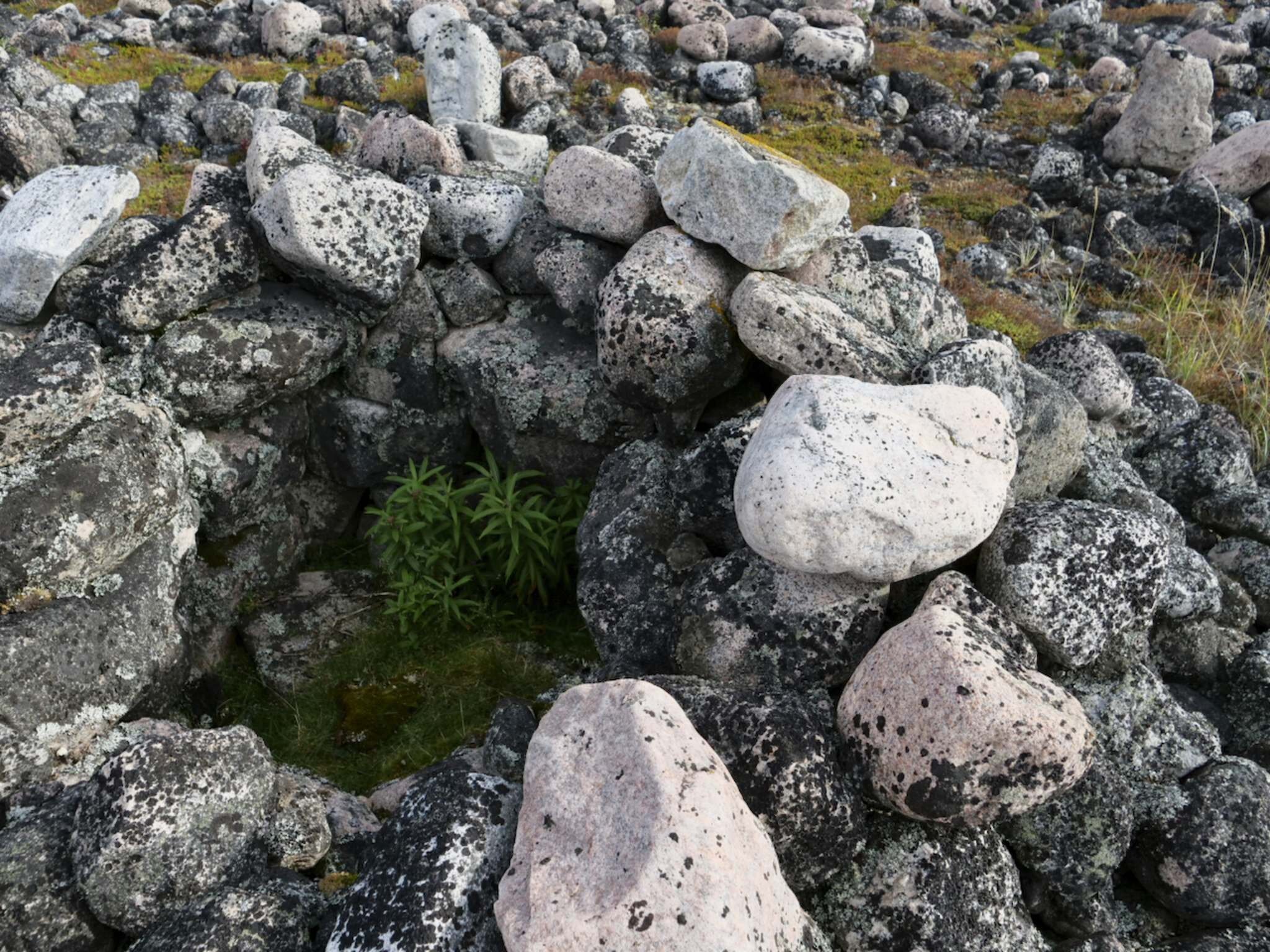Sacred site, breathtaking sight
AWE-INSPIRING INUIT HUNTING CAMP DATING BACK AT LEAST 1,000 YEARS OFFERS SOME OPTIMISM ABOUT CLIMATE CHANGE AND ENVIRONMENTAL ADAPTATION
OCT. 31, 2020 — WINNIPEG FREE PRESS
HUBBART POINT — In late summer the weather is completely unpredictable in northern Manitoba. One day it’s beautiful, with warm sunshine beaming down. Another, it’s miserable, with wind so strong it blows rain sideways.
Getting a helicopter up and flying depends on those always-changing conditions, but today it’s a go.
Oceans North, a charitable organization focused on marine conservation, offered the Free Press a seat on their expedition 70 kilometres northwest of Churchill, up the coast of Hudson Bay to a place called Hubbart Point, an ancient Inuit hunting camp.
In the late ’90s, this site garnered the interest of Manitoba archeologist Virginia Petch. She pursued radiocarbon dating of organic material from the site and found that the hunting camp had been used over the course of hundreds of years, with the oldest material dating back nearly 1,000 years.
"Imagine this, you have an insatiable curiosity and passion for discovery and you have been handed the uncommon opportunity to follow that passion into an area where little or no research has been conducted. This is my life!" Petch wrote in Above and Beyond in 2015.
Going back 1,000 years, the people who would have used this site weren’t Inuit, but rather their predecessors, the Thule people. At the turn of the last millennium, Thule people rapidly moved eastward across what is now the Canadian Arctic, from Alaska all the way to Greenland.
Petch worked up the Hubbart Point hunting camp site, creating maps of the features found there with the help of several Inuit guides, or interpreters of sorts, including Johnny Mamgark. They tagged massive meat caches, canoe stands, multi-family tent rings, burial sites and so on. Petch drew up a list of more than 340 distinct features at the site.
“It was great to have an archeologist come there and check it out, and see all of these old artifacts and find out how old they are. It was kind of amazing to find out they were 1,000 years old.”
— Johnny Mamgark
"It was great to have an archeologist come there and check it out, and see all of these old artifacts and find out how old they are. It was kind of amazing to find out they were 1,000 years old," Mamgark says.
Unfortunately, the work Petch was doing, supported by Oceans North, Pew Charitable Trust and Inuit Heritage Trust, was cut short when she was diagnosed with cancer and died. Work at the site was suspended temporarily, the groups unsure how they should proceed.
Last summer, Petch’s passion for the site was handed off to a new archeologist who is looking to pick up the torch.
As the helicopter approaches Hubbart Point, it’s clear a couple of passes will be necessary to scare away the dozen bears loitering in the area. The thumping of the rotors sends them running, for a time at least.
Linda Larcombe, an archeologist with the University of Manitoba’s school of medicine, is overwhelmed upon landing at the site for the first time. "It is spectacular," she says. "There’s a lot of activity in one small space."
"At a lot of Manitoba archeological sites, everything is below the ground, there’s hardly anything to see on the ground. So it’s unusual to go to a place like this, where there’s remains and structures to actually see."
The raised piece of land juts out into Hudson Bay with the bright greens and yellows of coastal plant life surrounding the point. There are mounds of pink-hued boulders wrapped in layers of black, deadened lichen. Spending an hour at the site is barely enough time to take in all of the features; the enormity of the historical site is breathtaking.
"I feel like there’s a real presence here, which is difficult to describe in words, and probably also to photograph," says Paul Labun, a policy adviser with Oceans North.
In Inuktitut, this place is known as Qikiqtaarjuit, which roughly translates to "place of small islands." At the time the Thule people would have used this point, the water would have been much higher, as the ground in this area is rising, and has been since the last ice age in a process known as glacial isostatic adjustment. It was previously cut off from the mainland and was more protected from polar bears and other predators at the time.
Mamgark, the Arviat-based Inuk guide, wasn’t able to make the trip out to Hubbart Point in late August, but in a phone interview, he explains that this point maintains a special place in modern Inuit culture. While he and other hunters regularly travel to the area to hunt beluga, caribou, even wolves, they never set up camp there.
"We never camp on that island, no. We respect it too much. We don’t even go on that island," Mamgark says. "It is special, so special to us Inuit, but also to Manitobans. A special place where the beluga migration goes, polar bears, seals, just about everything. It’s very special."
The abundance of wildlife in one concentrated spot is likely why it’s maintained its importance over the course of generations, he says.
The history of people on the land is a big part of what makes the site so unique, but also so hard to understand. What was used at one time versus another? How many people would have used the site at once? Layer upon layer of structures intermingle with one another, obscuring the answers to those questions.
"They used a lot of the natural boulders around there to build the bases of structures, and then they would have used wood (or whale bones) to build the roofs of the structures. But all that remains are the large stones and the base of the structures. And there’s over 100 tent rings," Larcombe says.
"And then there’s also meat caches, which I’d always envisioned meat caches as small, little compact places of stacked rocks, but these things are huge."
“We never camp on that island, no. We respect it too much. We don’t even go on that island. It is special, so special to us Inuit, but also to Manitobans.”
— Johnny Mamgark
Some of them, at least a metre high. They’d have to be substantial enough to protect the meat from bears, after all.
"We know so little about that kind of Thule occupation, generally," Larcombe says. She hopes to be able to interest graduate students to conduct research out at Hubbart Point to help her make sense of the site. The carbon dates came from only from a couple of samples after minimal excavation. With more investigation, more history could easily be uncovered.
Larcombe and Labun are both hyper-cautious about intruding, but Mamgark says as long as the items that belong to the site are left there, he’s eager to learn more. His support is also contingent on researchers not getting in the way of the hunting.
"If we work together, I wouldn’t mind people coming there to study it," he says.
‘Manitobans don’t really think of ourselves as an ocean culture, or ocean people but we have a coast. We are an ocean province and it’s an amazing coast," said Chris Debicki, vice-president of policy development for Oceans North.
Debicki says a big reason for Oceans North to continue the research, though it might seem a bit off message for a conservation group, is to demonstrate the importance of marine mammals to humans throughout the history of this continent.
He also hopes the project highlights the cultural and intrinsic importance of beluga whales to the Inuit, bringing attention to why the population needs to be preserved.
One of the leading theories for how the Thule were so successful at migrating rapidly across the continent into new places, such as northern Manitoba, is that the climate warmed enough during the Medieval Warm Period, which ran from the year 900 until approximately 1300.
"The climate warmed, so the whales started moving," says Lorraine Brandson, the curator of Churchill’s Itsanitaq Museum. The Thule culture, as a whole, evolved alongside the expansion of the whale’s territory, she explains. Then with the Little Ice Age, between the 16th and 19th centuries, encampments became smaller as the region became less productive, hunting less successful.
"So there is a climate-change aspect to their culture. That environmental explanation is the main explanation archeologists use… for their shifts in culture."
“What (our research) shows is that the area has been productive over a long period of time, and productive through different climatic cycles."
— Chris Debicki
Debicki sees the connection between climate change and the archeological dig as a twisted source of optimism. Climate change can have devastating effects, but somehow, in some form, this ecosystem seems to endure.
But what that reality looked like for people in a different time, in a different climate, could be used to develop conservation and adaptation efforts now as the world faces a much faster and much more severe change.
"What (our research) shows is that the area has been productive over a long period of time, and productive through different climatic cycles," he says. "It’s not to say that (in this) area the change isn’t going to be cataclysmic and disruptive, but there’s a good probability, based on historical record, that it will remain productive."
This article was a part of a 16-part series published in the Winnipeg Free Press titled Bearing North: An Exploration of Climate Change’s Impact on the Churchill Region. Read more of the series here.





